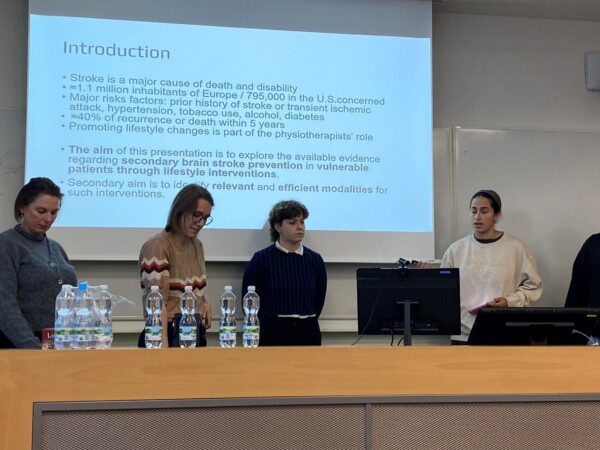
Savonia Article Pro: Lifestyle intervention as a secondary stroke prevention in vulnerable patients
Savonia Article Pro is a collection of multidisciplinary Savonia expertise on various topics.
This work is licensed under CC BY-SA 4.0
INTRODUCTION
Evidence-Based Physical Therapy (EBP) uses the best research evidence with clinical expertise and user’s preferences to produce the most appropriate and effective care. At week 43 in 2024, we had Blended Intensive program (BIP) in Czech Republic, Charles University about EBP. This BIP program opened with welcome words of the president of The European Network of Physiotherapy in Higher Education (ENPHE) and followed with the basis of EBP and teachers who highlighted the main challenges at different Physical Therapy fields (Picture 1).
More than 43 physiotherapy students and 9 teachers from five universities (Savonia University of Applied Sciences, Finland, Universidade da Coruña, Spain, Charles University Prague, Universidad Europea de Madrid, Spain and CEERRF, France), actively participated this week and shared experiential group dynamics and social activities. Students worked together and wrote articles devoted to the following themes: Evidence Based in sport, prevention, injuries, neurological diseases, respiratory diseases, cardiovascular diseases, children and older adults. In this learning task, students practiced conducting a mini review and using PEDRO scale to assess the quality of a studies. In the following you can consult the work presented by the students on secondary stroke prevention topic.
BACKGROUND
Nowadays, stroke is a major cause of death and disability, affecting ≈1.1 million inhabitants of Europe (Flach et al. 2020). The major risk factor for having a stroke is having a prior history of stroke or transient ischemic attack hypertension, smoking, alcohol, diabetes and hyperlipidemia. There is approximately 40% recurrence of stroke or death within 5 years following the first stroke (Wafa et al. 2020). Promoting health is an integral part of physiotherapists’ role and entails facilitating lifestyle changes in the frame of secondary stroke prevention.
The aim of the group work is to explore the available evidence regarding secondary brain stroke prevention in vulnerable patients through lifestyle interventions. The secondary aim is to identify relevant and efficient modalities for such interventions and recognize the ones that work best.

METHODS
We used the PICO system to search for articles. First, we determined eligibility criteria, searched for randomized controlled trials, population (adults after stroke or recent transient ischemic attack), intervention (educational or support programs aimed at lifestyle change – diet, exercise, medication adherence), control group (any other preventive intervention or none), and outcomes (recurrence of stroke or TIA, prevalence of risk factors). Articles that were in Czech, Finnish, French or Spanish and articles published more than 10 years ago were excluded from the search (exclusion criteria). At least 2 reviewers screened all identified articles by searching electronic databases – PubMed and ScienceDirect with this search terms (stroke, prevention OR preventive, vulnerable) based on this search equation: In Title/Abstract: stroke AND (preventive OR prevention) AND (physiotherapy* OR exercise* OR rehabilitation) AND (vulnerable OR smoke* OR tobacco OR lipidemia*OR *tension OR diabetes) + (Filter Randomized Control Trial). Each reviewer retrieved the data from the articles and assessed the articles they read. The PEDRO scale was used to assess the methodological quality of each article, which was rated as high (> = 8/10) or low (<8/10 on the PEDRO scale).
RESULTS
64 studies were screened, resulting in 6 integral text assessments (Picture 2). Finally, one study (Deijel at al. 2022) could not be included in the conclusion because it was not relevant to the main topic of this research. The 5 results of the included studies are presented below.

The study by Towfinghi (2020) identified the effects of a six week intervention program that included weekly two hour group sessions led by an occupational therapist, self management tools and binder for handouts and action plan on top of the regular care on a group of a 100 patients located in Los Angeles. At 6 months follow-up, BMI assessment and health-related quality of life questionnaire results showed no significant changes.
A study completed by Evans-Hudnal (2014) found that in a group of 57 intensive care post stroke patients, where 27 patients were delivered cognitive behavioral therapy program, there were no statistically significant improvement in the intervention group, as measured by the Behavioral Surveillance Survey (BRFSS).
Sylaja (2021) completed a study (237 post-stroke patients) investigating the effect of “education visits” about healthy lifestyle choices delivered by healthcare workers in rural Kerala (INDIA). Significant changes in blood pressure were achieved in the intervention group (121 patients), whereas none were found for blood sugar levels.
The findings of a study by Wan (2016) were that in a group of 80 post stroke patients where half received telephone check-ups the healthy lifestyle choices did not differ from the other half, who were treated regularly.
Cheng (2018) found no significant difference in blood pressure in a group of 404 patients where 204 were offered to visit a clinic for either personal or group consultations regarding the importance of a healthy lifestyle in stroke prevention.
CONCLUSION
Considering the limits of our research which included using very few databases, low methodological quality of the studies, low frequency of interventions, and irrelevant title or inadequate description of important characteristics of the interventions, we conclude that the effect of lifestyle intervention in secondary stroke prevention in vulnerable patients is non-significant.
Authors:
Zuzana Ficenecová, physiotherapy student, Charles University, Czech Republic
Clara Fernández Riveiro, physiotherapy student, University of A Coruña, A Coruña, Spain.
Noa Vázquez Recouso, physiotherapy student, University of A Coruña, A Coruña, Spain.
Harold Flores Cordova, physiotherapy student, Universidad Europea de Madrid, Spain.
Miia Klemetti, physiotherapy student, Savonia, University of Applied Sciences, Kuopio, Finland.
Marine Veyrat, physiotherapy student, CEERRF, France.
Dagmar Pavlu, Physiotherapist, Assoc. Prof. Charles University, Czech Republic
Ivana Vláčilová, Physiotherapist, PhD., Charles University, Czech Republic
Marja Äijö, PT, PhD Principal Lecturer of gerontology and rehabilitation, Savonia, University of Applied Sciences, Kuopio, Finland.
Veronica Robles García, PhD. PT. OT. Lecturer, University of A Coruña, A Coruña, Spain.
Beatriz Martínez Toledo, PT. University of A Coruña, A Coruña, Spain.
Montserrat Fernández, PT, University of A Coruña, A Coruña, Spain.
Lorena Canosa Carro, PT, MSc, PhD. Lecturer at Universidad Europea de Madrid, Spain.
Adrien Pallot, PT, MSc, Lecturer at CEERRF, France
References:
Flach, C., Muruet, W., Wolfe, C. D. A., Bhalla, A., & Douiri, A. (2020). Risk and Secondary Prevention of Stroke Recurrence: A Population-Base Cohort Study. Stroke, 51(8), 2435–2444. https://doi.org/10.1161/STROKEAHA.120.028992
Wafa, H. A., Wolfe, C. D. A., Emmett, E., Roth, G. A., Johnson, C. O., & Wang, Y. (2020). Burden of Stroke in Europe: Thirty-Year Projections of Incidence, Prevalence, Deaths, and Disability-Adjusted Life Years. Stroke, 51(8), 2418–2427. https://doi.org/10.1161/STROKEAHA.120.029606
Wan, L-H., Zhang, X-P., Mo, M-M., Xiong, X-N., Ou, C-L., You, L-M., et al. (2016). Effectiveness of Goal-Setting Telephone Follow-Up on Health Behaviors of Patients with Ischemic Stroke: A Randomized Controlled Trial. Journal of stroke and cerebrovascular diseases, 25, 2259–70. https://doi.org/10.1016/j.jstrokecerebrovasdis.2016.05.010
Cheng, E. M., Cunningham, W. E., Towfighi, A., Sanossian, N., Bryg, R. J., Anderson, T. L., Barry, F., Douglas, S. M., Hudson, L., Ayala-Rivera, M., Guterman, J. J., Gross-Schulman, S., Beanes, S., Jones, A. S., Liu, H., & Vickrey, B. G. (2018). Efficacy of a Chronic Care-Based Intervention on Secondary Stroke Prevention Among Vulnerable Stroke Survivors: A Randomized Controlled Trial. Circulation. Cardiovascular quality and outcomes, 11(1), e003228. https://doi.org/10.1161/CIRCOUTCOMES.116.003228
Evans-Hudnall, G. L., Stanley, M. A., Clark, A. N., Bush, A. L., Resnicow, K., Liu, Y., Kass, J. S., & Sander, A. M. (2014). Improving secondary stroke self-care among underserved ethnic minority individuals: a randomized clinical trial of a pilot intervention. Journal of behavioral medicine, 37(2), 196–204. https://doi.org/10.1007/s10865-012-9469-2
Towfighi, A., Cheng, E. M., Hill, V. A., Barry, F., Lee, M., Valle, N. P., Mittman, B., Ayala-Rivera, M., Moreno, L., Espinosa, A., Dombish, H., Wang, D., Ochoa, D., Chu, A., Atkins, M., & Vickrey, B. G. (2020). Results of a Pilot Trial of a Lifestyle Intervention for Stroke Survivors: Healthy Eating and Lifestyle after Stroke. Journal of stroke and cerebrovascular diseases: the official journal of National Stroke Association, 29(12), 105323. https://doi.org/10.1016/j.jstrokecerebrovasdis.2020.105323
Sylaja, PN., Singh, G., Sivasambath, S., Arun, K., Jeemon, P., Antony, R. et al. (2021). Secondary prevention of stroke by a primary health care approach: An open-label cluster randomised trial. J Clin Neurosci, 84, 53–9. https://doi.org/10.1016/j.jocn.2020.12.006.
Deijle, I. A., Hemmes, R., Boss, H. M., de Melker, E. C., van den Berg, B. T. J., Kwakkel, G., van Wegen, E., Bosboom, W. M., Weinstein, H. C., van Schaik, S. M., & Van den Berg-Vos, R. M. (2022). Effect of an exercise intervention on global cognition after transient ischemic attack or minor stroke: the MoveIT randomized controlled trial. BMC neurology, 22(1), 289. https://doi.org/10.1186/s12883-022-02805-z